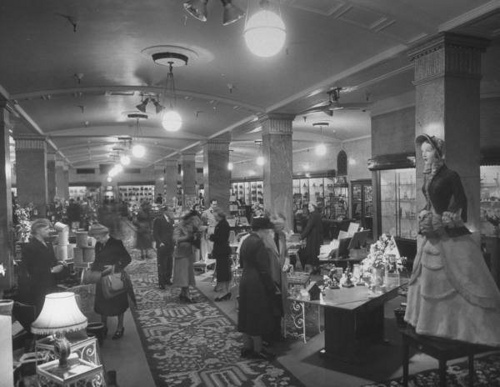
Harrod’s 1949
Tourists and Shoppers: London, Scotland, Cambridge
Note: To distinguish between speakers, I’m putting my comments in “regular” font, Maria’s in italics, and Anisa’s in bold.
Part One: Harrod’s and London
Warning: this section contains a controversial comment by Maria, but I think that, over sixty years after this trip, my mother can air her true feelings about Anisa’s shoes.
In 1949 Harrod’s was the de rigeur place to shop. Its fame rose in the late nineteenth century, when, after burning to the ground in December of 1883, Charles Harrod nonetheless fulfilled all of his Christmas orders. Soon its clientele was made up of the famous and fashion-oriented—Oscar Wilde, Lily Langtry, Ellen Terry, Noel Coward, A. A. Milne, members of the British Royal Family, and even Sigmund Freud. Who knows, the store may have inspired Freud’s book Civilization and its Discontents.
* * *
Sunday, July 29, over lunch, watching the Olympics–the men’s bicycle race. The conversation went something like this:
Terry: Wow, it looks like they’re going right through London.
Tom: No, there’s no way they’d bring the bike race right through the city; it would stop all the traffic.
Terry: Well, it looks like London, or, maybe it’s just one of the near suburbs that has buildings like part of London—the church and the bridge, could that be Putney?
Tom: There are a lot of churches with bridges just outside of London.
(minutes pass)
Terry: No, wait, that building—it’s Harrod’s; the race is in London.
* * *
By 1949 Harrod’s was still its plucky, cornucopic self, having dusted off most of the detritus of World War II. Once more it was a “must visit” place for tourists.
Above all, Harrod’s was Anisa’s go-to store in London—a nice, ten-minute walk straight down the Old Brompton rd. from the Rembrandt Hotel.; she made sure that she introduced Joan, Maria, and Carmen to Harrod’s.
This is how my mother remembers one conversation about Harrod’s:
Anisa went to Harrod’s and got a pair of shoes. She had pounds. She knew about Harrod’s because all her Arab friends spoke of Harrods as the non plus ultra place to shop. Y entonces she bought shoes there.
Anisa: Look at the shoes I got at Harrod’s. They are so comfortable.
I didn’t like them at all. Fueron muy muy, vaya, del tiempo de la guerra (they were very, very—well—wartime shoes): heavy, heavy Oxford-like things, but she was delighted with them.
Anisa: Because I’m a foreigner, I don’t need a ration for shoes.
Carmen: Maybe we could buy things for other people in England who are under rations.
Mother right away found the loophole.
Joan: “Where did you get the shoes?”
Anisa: Harrod’s
Joan: What is Harrod’s?
Anisa: Don’t you know what Harrod’s is?”
Anisa was surprised that Joan—who had already visited London–had never heard of Harrod’s. But Joan’s taste in clothing was tried and true Chicago-American; she was only happy when she was wearing Best and Company or Sax’s Fifth Avenue.
It is possible that Harrod’s is the place where Maria bought the white shoes she wore to visit the queen. (Must check on this.)
Part Two: What to Eat, Whom What to See.
With its generous breakfast, The Rembrandt Hotel took care of the travelers’ nutrition needs through the afternoon. But then the travelers had to deal with the food at English restaurants, food that was often gloppy, gristly, gruesome.
Then, enlightenment:
Maria: Somebody said,”Just go to the Indian restaurants; they have the best food.”
Maria: Anisa, why didn’t you tell me about Indian restaurants before?
Anisa: Oh, I thought you wouldn’t like that kind of food.
Indian food became the staple dinner for the last week or so in London, except for a grand dinner at the Berkeley Hotel, across from Fortnum and Mason. If it’s anything like the food served these days at the Berkeley, it must have been a wonderful experience. If you go to the Berkeley August 2012, you can start with “Foie gras, pineapple, cinnamon, brioche,” then move to “halibut, cockles, razor clams, fennel” or “suckling lamb, beans, oregano, Flower Marie,” pause for a selection from the cheese trolley, move to “moelleux, peanut, raspberry.” And I’m sure that they bring delicate little mini-biscuits to go with coffee and the bill.
According to Anisa, they also had a nice meal at the Savoy, so that’s two nice dinners in a month:
It seems there were many English people, whether bank owners or other people who lived in Cuba and knew your grandmother. I never realized there were so many Americans in London at the time—ordinary American citizens working in England, in some kind of American institution in England. There was this lady; your grandmother knew her from Cuba. She was very nice. She invited us to a cottage she had in one part of England. And we saw many American people playing tennis. It was lovely weather and very nice. Later on this lady friend of your mother’s—before we left England, we invited her for a dinner to the Savoy. She was her dear friend.
* * *
And, of course, the travelers met Anisa’s friends:
One day Anisa said, “I’d like you to come with us to see a friend.” I don’t remember if Joan went, but mother and I went, and suddenly I heard something that sounded to me like “wo ho hqwauw” and then the father said that the daughters were in their room—two little girls. Anissa went to see the girls and I heard something that to me sounded like “Oy, coockoo dhoo doo, tootoo too.”
Carmen: I don’t know where our family comes from originally, but these people sound just like us; the only difference is that they say these things in Arabic and we say them in Spanish—but the same sounds and tone, and saying things like, “Oh how pretty.” Just like us; we must have some Arab blood in us.
Frankly, for mother this was an amazingly valuable experience—that we got to know Arabic people not from books but in life, and saw that they are just like us. For me it was an enormous lesson.
My mother at this point suggested how Spanish must sound to Arabic-speaking people: “pah pah leh voo voo voo voo woo woo woo wo.”
Terry: the Mediterranean.
Part Three: Leaving London: Scotland and Cambridge.
At one point the travelers split up–Joan and Anissa going to Scotland, while Carmen and Maria went to Cambridge.
Anisa: While we were in England, Joan and I decided to go to Scotland. So we took the bus—a very nice coach—we took it from London. It stopped in York, which was beautiful. And there is Yorkminster the town, with its old walls. We spent the night there, and then we went to Edinburgh. I loved Edinburgh. There was a castle, and there was the Princess gate, and there was another castle. We enjoyed it very much.
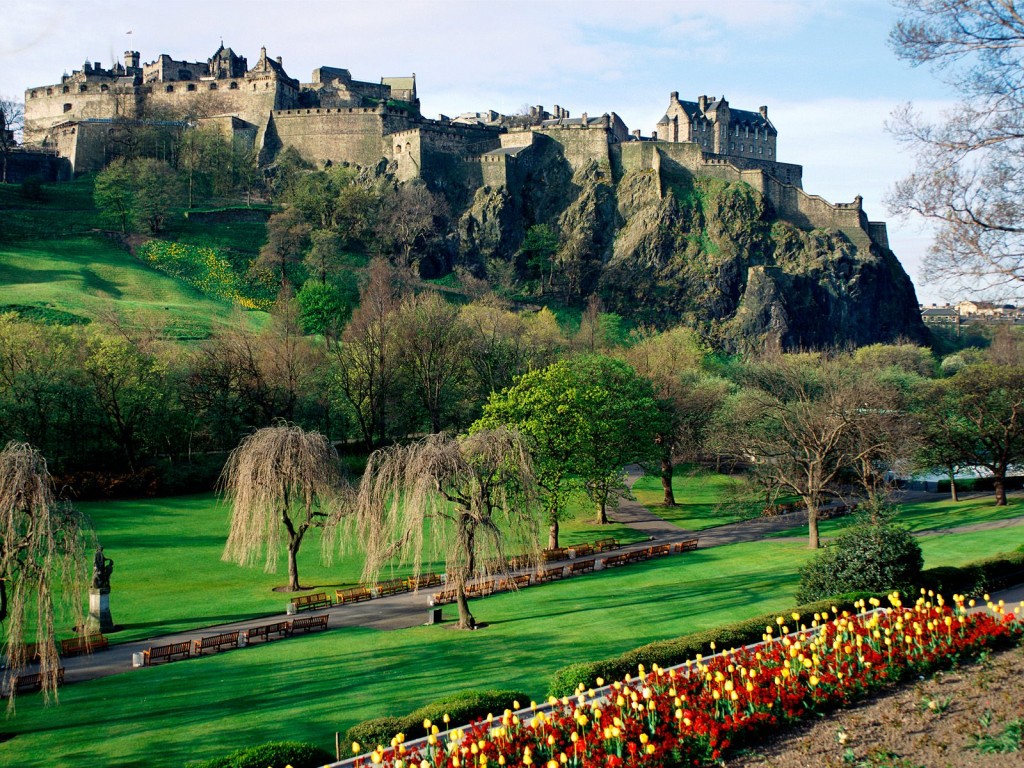
Edinburgh Castle, Scotland
Interruption by Terry: I have to pause here because I taught a course called “Queens” last fall, which was about writings by and about Catherine of Aragon, Mary Queen of Scots, and Queen Elizabeth I. We read the controversial sonnets by Mary (are they about Bothwell? Who knows.) and of course read about her all-too-colorful stay in Edinburgh castle, including how she fled Edinburgh for her life, and for a life of imprisonment in England, forced to leave behind her six-month-old son. It’s a beautiful castle, but must have seemed grim to Mary, isolated from her friends in France and in a vulnerable political position as a foreign Catholic queen.
Back to Anisa’s experiences:
Coming back, we went on another route, where we stopped in Chester. This—I was impressed with Chester because the town was of two levels—the streets and the shops. It was wonderful. And then we returned to London.
Every time we took the bus we stopped in some place to have coffee or tea. In the bus it seems they put the numbers in back of the seat. When Joan and I, got back in, we looked for the numbers, we looked a little bit confused. The English people, they looked at each other and said “Americans.” “Americans.”
Cambridge:
Background information: my mother is telling this story in the kitchen; this is what it’s like to have an interview with my mother.
Mami: Y entonces, Mamá knew un doctor en Cambridge y we went to Cambridge, y yo estaba looking for a job and he gave me a letter of recommendation someone in UNESCO whom he knew. And he was, I think, German-Jewish and he went by “Jake”; everyone called him “Jake.”
(Click, clack—my mother puts down her cup of tea.)
Carmen: He is English—English-English,”
Maria:, “Mamá, I’m sorry; este hombre no es inglés” (this man is not English).
(clackety-clackety-clack in the background)
Maria: Excuse me, the eggs are ready; I have to get them off the stove.
Terry: Did he have an accent?
Mami: No, well, his wife definitely had a German accent. And so I asked, “What part are you from?” And I got from his wife that they came from Bavaria. England was filled with German refugees.
(click of footsteps in the background—Elizabeth, who helps out with cleaning, has come in to wipe the counters in the kitchen)
But it was thanks to him that we came to Cambridge and we saw Cambridge in its glory—the weather was glorious.
And then—and this is typical of your grandmother, by the way. As I was being interviewed by the doctor—“Jake,” a little old man comes up and mother says:
Carmen: “I’m just enjoying the flowers, and everything is so wonderful; yesterday, we had the best strawberries.” And the next thing she knew the little old man had returned with a basket of rasberries, saying,
Little Old Man: I just wanted you to try our rasberries.
You know, it was a wonderful time. England was rediscovering itself.
(Sounds of water gushing from the kitchen sink.)
Jake took us punting on the Thames, y I think it was just mother and myself; and afterwards he took us to a place for tea, where you sat on the grass–it was very English, and there was a little boy running about, happy as a lark, and mamá–well, while I was finishing at Vassar, Doctor Gardiner, who had been my father’s doctor when he had cancer, found mother un jobcito en Children’s Hospital, so that mother could stay near me. And that’s where she met “Jake,” who was doing research—cancer research. And when Jake sees the healthy little boy running about shirtless, Jake says to mamá “Look, Carmen, no cancer!”
It was just a glorious, glorious time.
After that we met up with Joan and Anisa and then we had the “great episodes,” y es ir a Staines, with the queen.
PHOTOS SOURCE:
Harrods 1949: http://www.flickr.com/photos/brizzlebornandbred/4197239055/
Berkeley Hotel: http://www.dilos.com/hotel/3675/UK-England-GREATER-LONDON-London-Berkeley-Hotel%20Aug%201%202012
Edinburgh Castle: http://www.two4travel.net/wp-content/uploads/2012/03/Edinburgh-Castle-Scotland-728×546.jpg
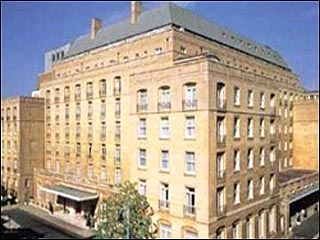
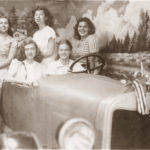
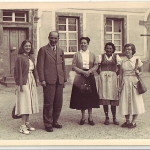
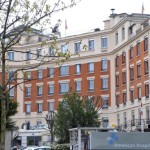
I like that our mother still uses her olive green, plastic Harrods tote. It’s probably about 25 years old.
Ok–I so totally forgot about that the Harrods tote.